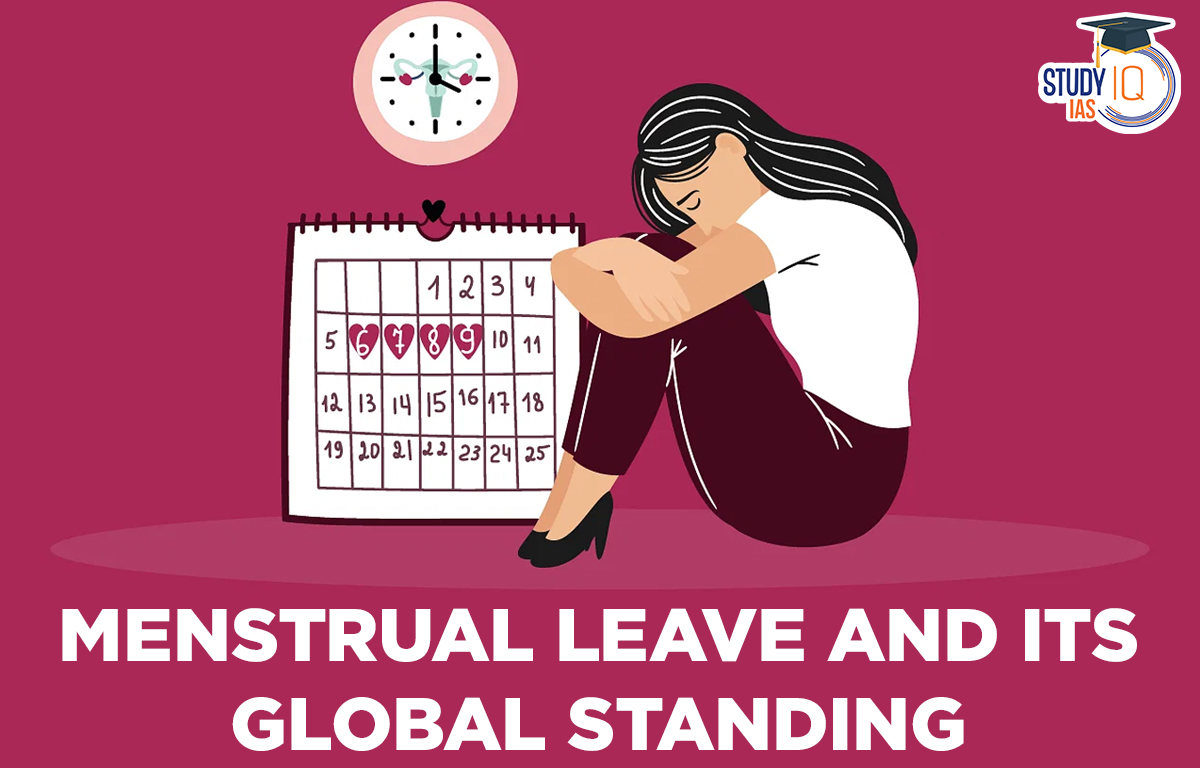Table of Contents
Context: Recently, the Supreme Court has refused to entertain a PIL about menstrual leave for workers and students across the country, calling it a policy matter.
What is Menstrual Leave?
- Menstrual leave or period leave refers to all policies that allow employees or students to take time off when they are experiencing menstrual pain or discomfort.
- In the context of the workplace, it refers to policies that allow for both paid or unpaid leave, or time for rest.
- Menstrual cycle: It is a series of natural changes in hormone production and the structures of the uterus and ovaries of the female reproductive system that makes pregnancy possible.
- Most women experience a menstrual cycle of 28 days— a normal cycle may vary from 23 to 35 days.
- Period pain, or Dysmenorrhea: It is a medical term used to describe painful menstrual cramps that occur just before or during menstruation.
- More than half of those who menstruate experience pain for a couple of days a month; for some it is debilitating enough to hamper daily activities and productivity.
- Between 15% to 25% of people who menstruate will experience moderate to severe menstrual cramps, according to a study by the University of Michigan.
- Premenstrual syndrome (PMS): PMS can cause physical and emotional symptoms, such as bloating, mood swings, and fatigue, in the days leading up to menstruation.
- Need for menstrual leave policies: They are designed with a view to allow women time off if they suffer from symptoms which may hamper their functioning and productivity.
- Arguments for and against menstrual leave:
| Arguments for | Arguments against |
| Health and Well-being: Menstrual or period leaves are important because they allow women to take care of their health and well-being during menstruation.
Ensure productivity: Menstrual leave helps ensure that women can fully participate in the workforce and can perform to the best of their abilities. Detaches stigma and discrimination: Additionally, menstrual leave can help reduce the stigma surrounding menstruation and promote a culture of openness and support for women. |
Burden on employers: Employers may be hesitant to provide menstrual leave due to concerns about productivity, staffing, and financial costs.
Stigma: Menstrual leave may perpetuate the stigma around menstruation and reinforce harmful stereotypes about women’s ability to work. Difficulties in implementation: Employers may struggle to verify whether an employee is genuinely experiencing menstrual symptoms, which could lead to resentment or disputes. |
What kind of menstrual leave policies are in place globally?
| Europe |
|
| Asia |
|
| Africa |
|
| Other regions |
|
What attempts are being made in India?
- Private Companies: Companies like Zomato, Swiggy, Byjus have brought menstrual leave policies.
- State governments: Bihar and Kerala are the only states to introduce menstrual leave to women.
- The Bihar government has introduced its menstrual leave policy in 1992, allowing employees two days of paid menstrual leave every month.
- Recently, the Kerala government has also announced that the State’s Higher Education department will now grant menstrual and maternity leaves for students in universities.
- Parliamentary measures: The measures taken in the Parliament have been mostly unsuccessful.
- For example, The Menstruation Benefits Bill, 2017 was introduced in the Parliament but was disregarded as an unclean topic.
- Later, the Women’s Sexual, Reproductive and Menstrual Rights Bill was introduced in 2018 but wasn’t approved.
- However, again The Right of Women to Menstrual Leave and Free Access to Menstrual Health Products Bill, 2022 will be introduced in the Parliament.
- It provides for three days of paid leave for women and transwomen during the period of menstruation.
- It also seeks to extend the benefit for students.
- The Bill states that approximately 40% of girls miss school during their periods, and nearly 65% said it had an impact on their daily activities at school.


 UPPSC Previous Year Question Papers, Dow...
UPPSC Previous Year Question Papers, Dow...
 Most Commonly Used Cancer Drugs and Thei...
Most Commonly Used Cancer Drugs and Thei...
 Tansen Biography, Musical Legacy and Mas...
Tansen Biography, Musical Legacy and Mas...





















